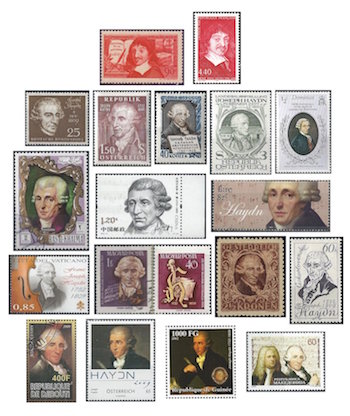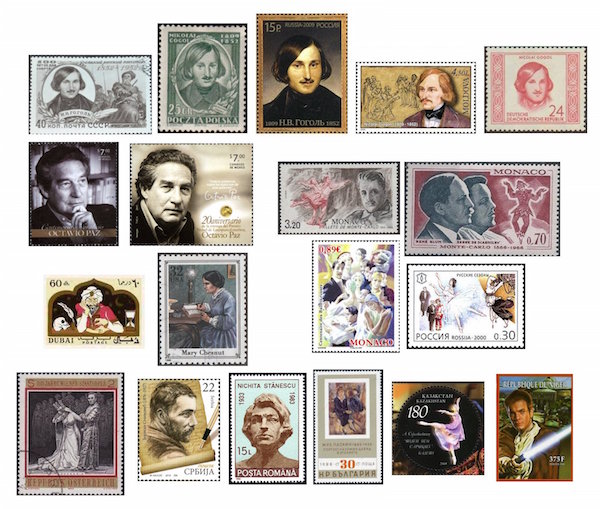The Arts on the Stamps of the World — March 31
An Arts Fuse regular feature: the arts on stamps of the world.

By Doug Briscoe
Born on March 31 were the great masters of their respective arts Franz Joseph Haydn (1732 – 31 May 1809) and Nikolai Gogol, along with Nobel Prize winner Octavio Paz, ballet impresario Sergei Diaghilev, English translator of the Rubaiyat Edward FitzGerald, Civil War diarist Mary Chesnut, and German soprano Elisabeth Grümmer, among others.
But first we must give at least a passing mention of René Descartes (31 March 1596 – 11 February 1650), and not just on general principles for his brilliance, but because he also wrote a treatise on music theory with the title Musicae Compendium (1618). Betcha didn’t know that.
I present my complete Haydn stamp collection for your viewing pleasure. Several Haydn stamps were issued for his bicentenary in 2009, but so far I’ve collected only the ones from Ireland and Macedonia (on which latter he is shown with Handel). Haydn may not be on everybody’s list of Ten Greatest Composers, but he wrote such a vast amount of enormously gratifying music—symphonies, quartets, sonatas, masses, and so much more, literally hundreds of superb scores—that he has secured a position on my personal Ten Favorite Composers list. I suppose over the years I have listened to about as much Haydn as I’ve listened to any other composer.
Something I never knew about Nikolai Gogol (31 March [O.S. 19 March] 1809 – 4 March [O.S. 21 February] 1852) is that he was apparently gay. It seems the one love of his life was a young count Gogol met while living in Italy, but their time together was brief, as the Count Joseph Vielhorskiy died the year after Gogol met him. Gogol’s fiction inspired Janáček’s orchestral work Taras Bulba and operas by Shostakovich (The Nose, 1928), Shchedrin (Dead Souls, 1976), and Weinberg (The Portrait, 1980). More than a hundred movies have been made of his stories.
Mexican poet Octavio Paz (March 31, 1914 – April 19, 1998) won the Nobel Prize for Literature in 1990. He had served Mexico as a diplomat in New York, Paris, Tokyo, Geneva, and India, but resigned as a protest against the government’s massacre of dozens or hundreds of students and others in Mexico City just prior to the 1968 Olympics. He accepted professorial positions at both Cambridges (he held the Charles Eliot Norton professorship at Harvard from 1970 to 1974). In 1956 he wrote a play based on Hawthorne’s story of “Rappaccini’s Daughter”, which in turn was set as an opera by Daniel Catán in 1992.

The founder and director of the Ballets Russes, Sergei Diaghilev (31 March [O.S. 19 March] 1872 – 19 August 1929), is the man we have to thank for Stravinsky’s Firebird, Petrushka, and The Rite of Spring, Ravel’s Daphnis et Chloé, Debussy’s Jeux, Respighi’s La Boutique fantasque, Poulenc’s Les biches, several ballets by Prokofiev, and much more. The Principality of Monaco has issued three stamps in his honor, one from 1966, wherein he is paired with René Blum, who founded the Ballet de l’Opéra at Monte Carlo, another from 1986, and a 21st century one on which he is shown among the artists who were involved in the Ballets Russes. He can also barely be discerned at far left (with cane) on a Russian ballet stamp from 2000.
English poet Edward FitzGerald (31 March 1809 – 14 June 1883) is much better known for his translations from The Rubaiyat of Omar Khayyám than for his original work. He has no stamp, but Dubai has issued a minisheet for the Rubaiyat, and that will have to do.
Mary Chesnut (née Miller) (March 31, 1823 – November 22, 1886) has earned immortality for the journals she kept during the Civil War. These writings first appeared posthumously in 1905; the scholarly 1981 edition prepared by C. Vann Woodward, Mary Chesnut’s Civil War, won the Pulitzer for History in 1982. Edmund Wilson had described it as “a work of art.” Her stamp is one from a sheet of twenty issued in 1995 in memory of various personalities and battles of the war.
Elisabeth Grümmer (31 March 1911 – 6 November 1986), née Schilz, was born in Alsace-Lorraine to German parents. The family was forced to leave Lorraine in 1918 and relocated to Meiningen, where Elisabeth met and married the theater orchestra’s concertmaster Detlev Grümmer. She met Herbert von Karajan (his birthday is coming up on April 5), who encouraged her to make her operatic début as the First Flowermaiden in Wagner’s Parsifal in 1940. After the war, in which her husband was killed in a bombing raid, she moved to Berlin and was much in demand throughout Europe and in the United States, specializing in the German repertoire, both in opera and lieder. On the stamp she is shown in a scene from Lohengrin with Wolfgang Windgassen as part of a 1969 set commemorating the centenary of the Vienna State Opera.

Our next two birthday boys have rather similar names, and I thought placing them adjacent to each other may help fix them in your minds. Well, all right, my mind. The Serbian Borisav “Bora” Stanković (1876 – 22 October 1927) and the Romanian Nichita Stănescu (1933 – December 13, 1983) were both writers, with Stănescu specializing in poetry, while Stanković was more of a novelist and short story writer. The latter’s finest work is probably his 1910 novel Impure Blood, cited as the first Serbian novel to receive international praise. In addition to his fiction he wrote two plays. Stănescu produced twenty volumes of poetry between 1906 and 1982 and was nominated for a Nobel Prize in 1980. Alcoholism destroyed his health, and he died at the age of 50.
Remaining for the moment in Eastern Europe, we turn to Bulgarian-born painter Julius Mordecai Pincas (March 31, 1885 – June 5, 1930), who also suffered from alcoholism as well as depression. His father was Sephardic Jewish and his mother Italian-Serbian, and Julius grew up speaking Judaeo-Spanish.. He made his first drawings, they tell me, as a teenager at a brothel in Bucharest, a grounding that seems to have given direction to much of his later work. He studied in Vienna and Munich and began using the anagram Pascin (pahss-KEEN) in response to his father’s displeasure at the idea of the family name being associated with the drawings Julius submitted to magazines. He moved to Paris in 1905, started painting around 1907, and had a dozen works displayed at the famous 1913 Armory Show in New York. He lived in the US during and after World War I, doing much travel in the South, with an excursion to Cuba. Pascin even adopted US citizenship, though he returned to Paris in time to get a mention in Hemingway’s Movable Feast and died there by his own hand at the age of 45.
Composer and pianist Almas Yermekovich Serkebayev was born on this date in 1948 in Almaty, then known as Alma-Ata in the Kazakh Soviet Republic. He comes from a musical family, his uncle Murat a violinist and conductor and his cousin the violinist Zhamilya Serkebayeva. A Boston resident since 1988, Serkebayev has written works for the stage, symphonies, concertos, and chamber music. The stamp from Kazakhstan, celebrating his ballet Tlep and Sarykyz, was issued in 2009, the same year as the première of the ballet.
Scottish actor Ewan McGregor (born 31 March 1971) is known for his breakthrough role in Trainspotting, a movie I could never understand the appeal of, but he’s on a stamp (from Niger!) only because of his participation in the Star Wars franchise.
It’s a pity that the beautiful poetry of Andrew Marvell (31 March 1621 – 16 August 1678) has not yet earned him a stamp.
A graduate of the University of Massachusetts with a B.A. in English, Doug Briscoe worked in Boston classical music radio, at WCRB, WGBH, and WBUR, for about 25 years, beginning in 1977. He has the curious distinction of having succeeded Robert J. Lurtsema twice, first as host of WGBH’s weekday morning classical music program in 1993, then as host of the weekend program when Robert J.’s health failed in 2000. Doug also wrote liner notes for several of the late Gunther Schuller’s GM Recordings releases as well as program notes for the Boston Classical Orchestra. For the past few years he’s been posting a Facebook “blog” of classical music on stamps of the world, which has now been expanded to encompass all the arts for The Arts Fuse.
